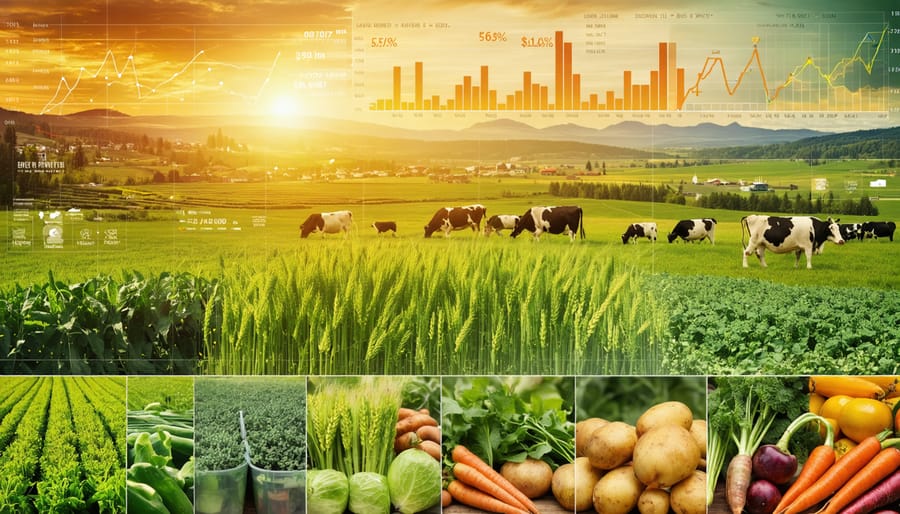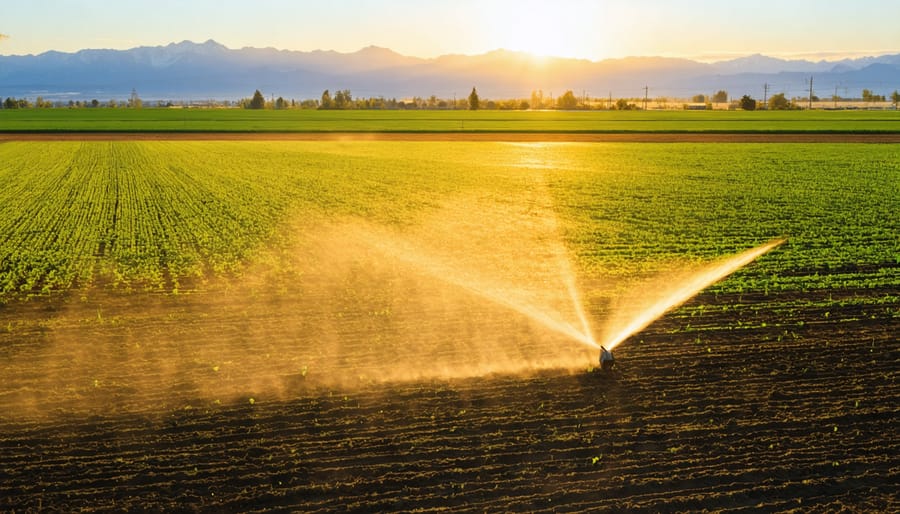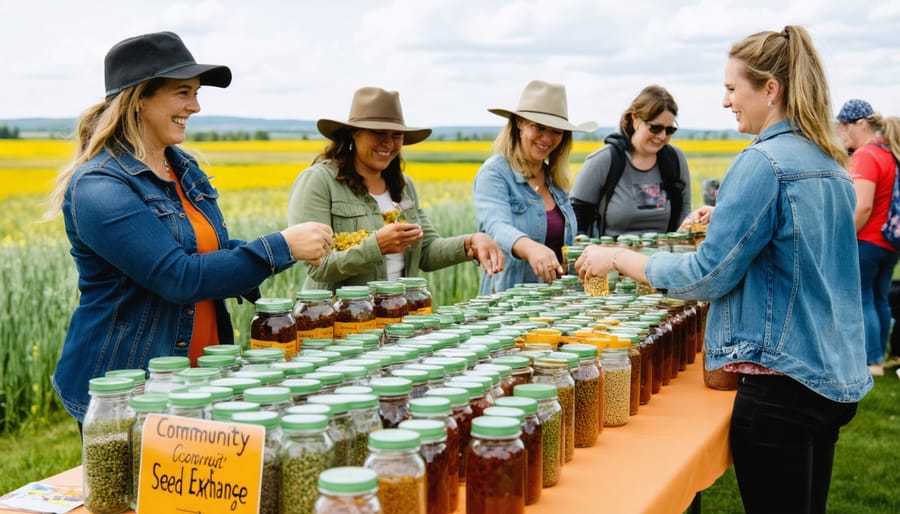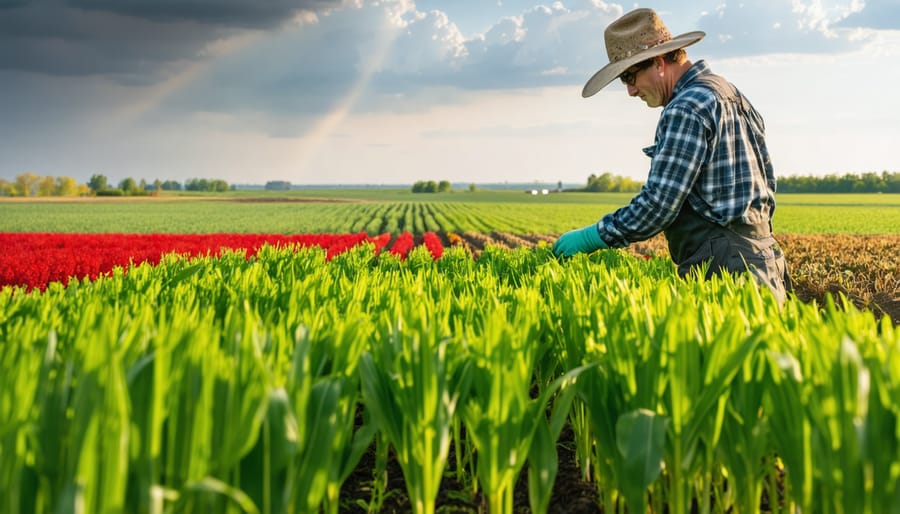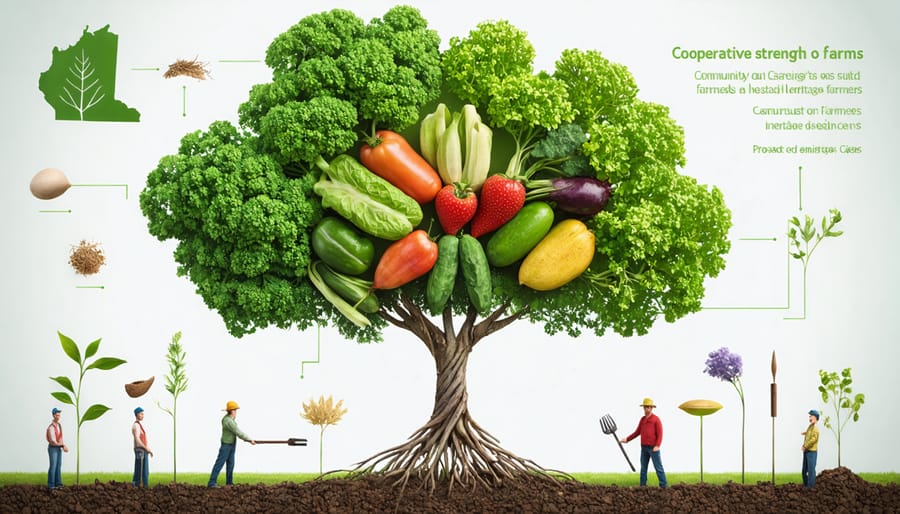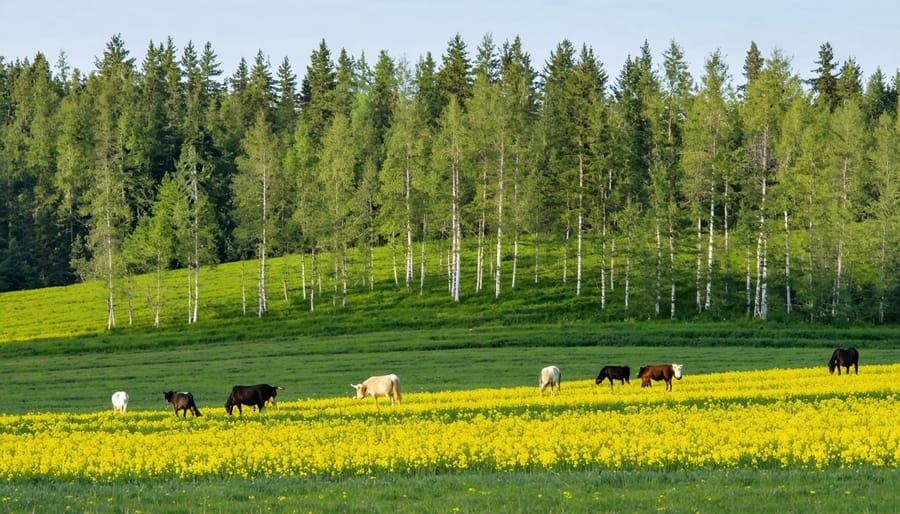Organic farming has emerged as a beacon of sustainable agriculture, with Canadian organic producers reporting net profits up to 30% higher than conventional farms. Across Alberta’s diverse agricultural landscape, from the rich soil of Peace Country to the southern prairies, farmers are discovering that the premium pricing and lower input costs of organic operations can significantly boost their bottom line. While the three-year transition period requires careful planning and initial investment, government support programs, growing market demand, and established distribution networks have created a robust foundation for profitable organic ventures. Recent data from Statistics Canada shows organic products commanding price premiums of 20-200% above conventional alternatives, with particularly strong returns in grain, dairy, and specialty crop sectors. This economic potential, combined with reduced exposure to synthetic input costs and increasing consumer preference for organic products, presents a compelling case for farmers considering the shift to organic production methods.
The Real Economics of Organic Farming in Alberta
Price Premiums for Organic Crops
Organic crops consistently command higher market prices compared to their conventional counterparts in Canadian markets. Recent data from Alberta Agriculture shows organic wheat fetching premiums of 150-200% above conventional prices, while organic oats typically earn 80-120% more. These premium margins have remained relatively stable over the past five years, providing reliable income potential for farmers.
In Alberta’s farmers’ markets, organic vegetables like carrots and potatoes regularly sell for 30-50% more than conventional produce. For specialty crops such as organic quinoa and hemp, premium margins can reach up to 300%, though these markets tend to be more volatile and require established buyer relationships.
Local organic dairy processors report paying farmers 15-20% more for organic milk compared to conventional, while organic egg producers receive premiums averaging 25-30% higher. However, it’s important to note that these premiums can fluctuate based on seasonal availability and market demand.
These price advantages help offset the typically higher production costs and lower yields associated with organic farming, making it a viable option for producers willing to navigate the certification process and develop strong market connections.
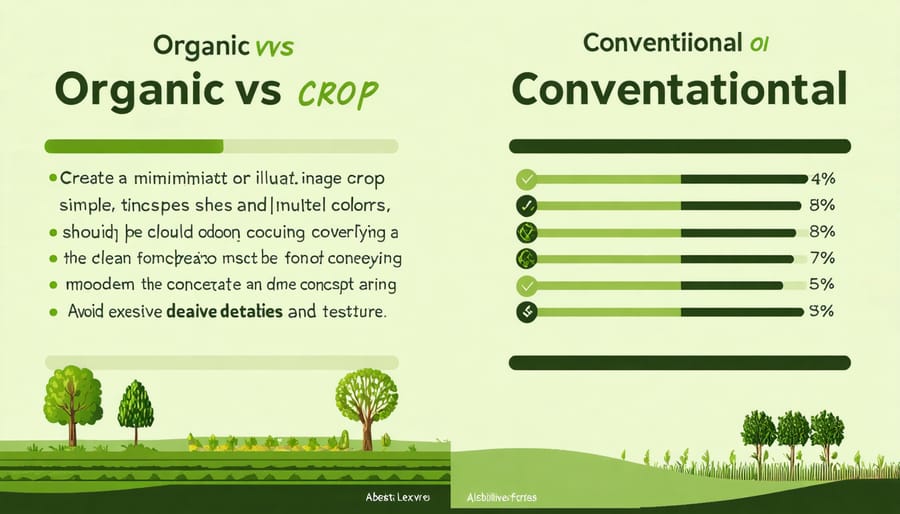
Operating Cost Comparison
When comparing operating costs between organic and conventional farming in Alberta, several key differences emerge. Organic operations typically face higher labor costs, averaging 15-20% more than conventional farms due to increased manual weed control and monitoring requirements. However, these are offset by reduced expenses in other areas.
Organic farmers save significantly on synthetic inputs, with studies from the University of Alberta showing 30-40% lower costs for fertilizers and pest control. While organic amendments like compost and green manure may cost $200-300 per hectare initially, they provide long-term soil benefits that reduce input needs over time.
Equipment costs can be comparable between both systems, though organic farmers often invest in specialized machinery for mechanical weed control. The initial investment ranges from $5,000 to $25,000 for implements like tine weeders or rotary hoes.
Certification costs for organic operations in Alberta typically run $1,000-1,500 annually, but this expense is often recovered through premium pricing. Many farmers report that after the three-year transition period, total operating costs stabilize at levels similar to or slightly below conventional farming, particularly as soil health improves and natural systems become established.
Available Financial Support Programs
Federal Organic Transition Support
The Canadian government has significantly expanded its support for farmers transitioning to organic production through various federal programs. The organic transition initiative offers substantial financial assistance, providing up to $20,000 per farm to help offset certification costs and implement necessary changes during the three-year transition period.
Through Agriculture and Agri-Food Canada (AAFC), farmers can access specialized funding streams that cover soil testing, organic pest management training, and essential equipment modifications. The Canadian Agricultural Partnership (CAP) program provides matching funds of up to 50% for infrastructure improvements specifically related to organic conversion.
For Alberta farmers, additional provincial support complements federal programs, creating a comprehensive support network. The Alberta Organic Producer Assistance Program offers technical expertise and mentorship opportunities, connecting transitioning farmers with experienced organic producers in their region.
Recent enhancements to these programs include interest-free loans for organic transition projects and grants for developing market connections. Farmers can also access specialized organic agriculture advisors through AAFC regional offices, who provide personalized guidance throughout the certification process.
To maximize these benefits, farmers are encouraged to work with their local agricultural extension offices to develop detailed transition plans that align with available funding opportunities. Early application is recommended as many programs operate on a first-come, first-served basis.
Alberta-Specific Grants
Alberta farmers transitioning to organic agriculture have access to several provincial grant programs designed to support sustainable farming practices. The Canadian Agricultural Partnership (CAP) in Alberta offers specific funding streams for organic certification, with eligible producers receiving up to $8,000 over the course of five years to cover certification costs.
The Environmental Stewardship and Climate Change Producer Program provides cost-sharing opportunities of up to 70% for projects that improve soil health and implement sustainable farming practices. Organic farmers can access between $5,000 and $100,000 for qualifying initiatives.
The Agriculture Training Support Program offers funding for skills development and training related to organic farming practices. This includes coverage for courses, workshops, and mentorship programs essential for successful organic operations.
To apply for these grants, farmers must first register with the Alberta Agriculture and Forestry portal and complete an Environmental Farm Plan. Applications typically open seasonally, with deadlines varying by program. Supporting documentation, including business plans and environmental assessments, may be required.
Local organic farming associations, such as Organic Alberta, provide assistance with grant applications and can connect farmers with experienced mentors who have successfully navigated the funding process. They also offer regular workshops on grant writing and program requirements, helping ensure higher success rates for applicants.
Private Sector Financial Solutions
Private sector funding opportunities have become increasingly accessible for organic farmers across Alberta. Local credit unions like Servus and Connect First offer specialized agricultural loans tailored to organic operations, with competitive interest rates and flexible repayment terms. These institutions understand the unique challenges and timelines associated with organic transition periods.
Several innovative partnership models have emerged, connecting organic farmers with private investors through equity-sharing arrangements. Programs like FarmWorks Investment Co-operative enable farmers to access capital while maintaining operational control of their farms. Additionally, organizations providing financial assistance for organic farmers often facilitate connections with angel investors interested in sustainable agriculture.
Contract growing arrangements with organic food processors and retailers represent another viable financing option. Companies like Nature’s Path and Organic Valley frequently offer advance contracts and sometimes provide transition funding to help conventional farmers switch to organic production. These partnerships often include guaranteed purchase agreements, providing financial security during the critical early years.
Many Alberta farmers have also found success through crowdfunding platforms specifically designed for agricultural ventures. Platforms like FarmFundr and Harvest Returns connect organic producers with investors passionate about sustainable agriculture, offering both debt and equity financing options. These platforms typically require detailed business plans but can provide significant capital without the stringent requirements of traditional lending institutions.
Success Stories: Alberta’s Profitable Organic Farms
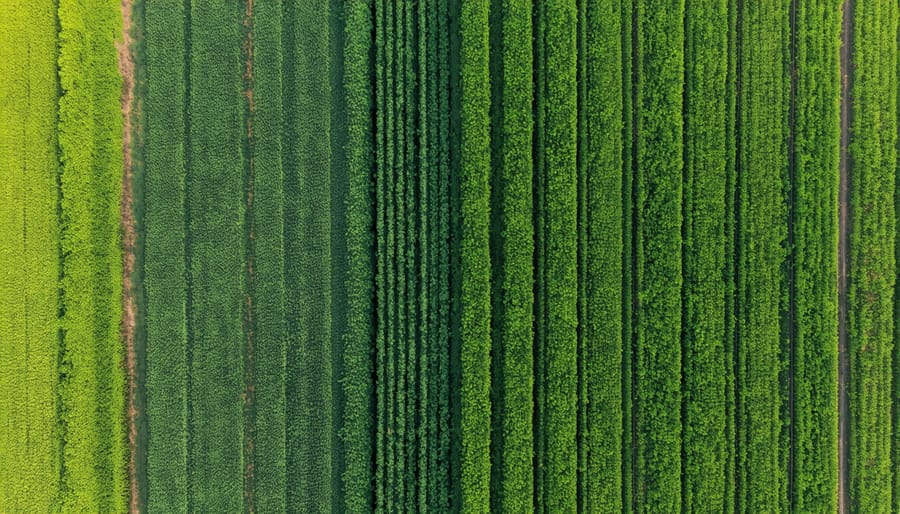
From Conventional to Organic: The Miller Family Farm
Located just outside of Coaldale, Alberta, the Miller Family Farm’s journey from conventional to organic farming stands as a testament to the potential profitability of organic agriculture. In 2015, John and Sarah Miller made the bold decision to transition their 400-hectare grain operation to organic production, despite initial skepticism from neighboring farmers.
During the three-year transition period, the Millers faced challenges including reduced yields and the learning curve of organic pest management. However, they offset these challenges by implementing a diverse crop rotation system and securing premium prices through advance contracts with organic grain buyers.
By 2019, their operation was fully certified organic, and their profit margins increased by 35% compared to their conventional farming days. The Millers attribute their success to three key strategies: careful financial planning during the transition period, building strong relationships with organic buyers, and investing in mechanical weed control equipment.
“The initial investment was significant,” says Sarah Miller, “but we recovered our costs within two years of certification through premium pricing and lower input costs.” The family now grows organic wheat, oats, and pulses, with gross margins averaging $200 more per hectare than conventional operations in their area.
The Millers also discovered unexpected benefits, including improved soil health and reduced operational costs due to the elimination of synthetic fertilizers and pesticides. Their success has inspired five other local farms to begin their organic transition.
Building a Premium Brand: Red Deer Valley Organics
Red Deer Valley Organics, located just outside of Drumheller, Alberta, has become a shining example of how premium branding can elevate an organic farming operation. Founded by Sarah and Mark Thompson in 2012, this family farm transformed from a conventional grain operation into a thriving organic enterprise that now commands top dollar for its products.
The Thompsons focused on building a distinct brand identity that emphasizes their commitment to soil health and biodiversity. Their signature line of ancient grains and heritage vegetables carries professional packaging featuring their distinctive mountain valley logo and tells the story of their regenerative farming practices.
By developing value-added products like their popular organic spelt flour and custom grain blends, they’ve increased their profit margins significantly. Their direct-to-consumer sales through farmers’ markets and their online store generate 40% higher returns compared to wholesale distribution.
Marketing initiatives, including farm-to-table events and educational workshops, have helped build a loyal customer base willing to pay premium prices. Their social media presence showcases daily farm life and sustainable practices, connecting urban consumers with their food source.
The farm’s success stems from understanding their target market – health-conscious consumers willing to pay more for quality organic products with a story. By investing in brand development and creating unique product offerings, Red Deer Valley Organics has achieved a 25% year-over-year revenue growth since 2018.
Making Your Organic Operation More Profitable
Smart Certification Planning
Planning your certification journey strategically can significantly impact your farm’s profitability during the transition period. Understanding the organic certification requirements early allows you to align your farming practices gradually while maintaining income streams.
Start by conducting a thorough assessment of your current operations and identify areas that need modification. Many Alberta farmers find success by converting their land in phases, typically starting with 20-30% of their total acreage. This approach allows you to test organic methods while maintaining conventional revenue streams.
Consider timing your certification process with market demands. For example, if you’re planning to grow organic grains, align your transition period to coincide with peak market periods. Many successful Alberta organic farmers schedule their certification completion for early spring, allowing them to capitalize on premium prices during the growing season.
Documentation preparation should begin at least 12 months before applying for certification. Keep detailed records of soil amendments, crop rotations, and pest management strategies. This proactive approach not only streamlines the certification process but also helps identify potential cost-saving opportunities.
Connect with local organic farming associations and mentors who have successfully navigated the certification process. Their experience can help you avoid common pitfalls and optimize your transition timeline for maximum profitability.
Diversification Strategies
Successful organic farmers in Alberta know that relying on a single revenue stream can be risky. Many have found success by implementing multiple income sources throughout their operations. A popular approach is value-added processing, where farmers transform their raw organic produce into premium products like organic jams, dried herbs, or cold-pressed oils.
Direct-to-consumer sales through farmers’ markets and Community Supported Agriculture (CSA) programs have proven particularly profitable in urban centres like Calgary and Edmonton. These channels typically offer better margins than wholesale and help build strong customer relationships.
Agritourism has emerged as another lucrative opportunity, with farms offering educational tours, harvest festivals, and farm-to-table dining experiences. Several Alberta organic farms have successfully incorporated bed-and-breakfast operations or seasonal events that capitalize on urban residents’ interest in rural experiences.
On-farm processing and storage facilities can generate additional income by serving other local organic producers. Some farmers have found success in organic seed production, which commands premium prices and helps meet the growing demand for organic-certified seeds.
Consider diversifying your crop rotation to include high-value specialty crops like quinoa or hemp, which are well-suited to Alberta’s climate. Many successful organic operations also integrate livestock, using animals for natural pest control and soil fertility while creating additional revenue streams through meat, dairy, or egg sales.
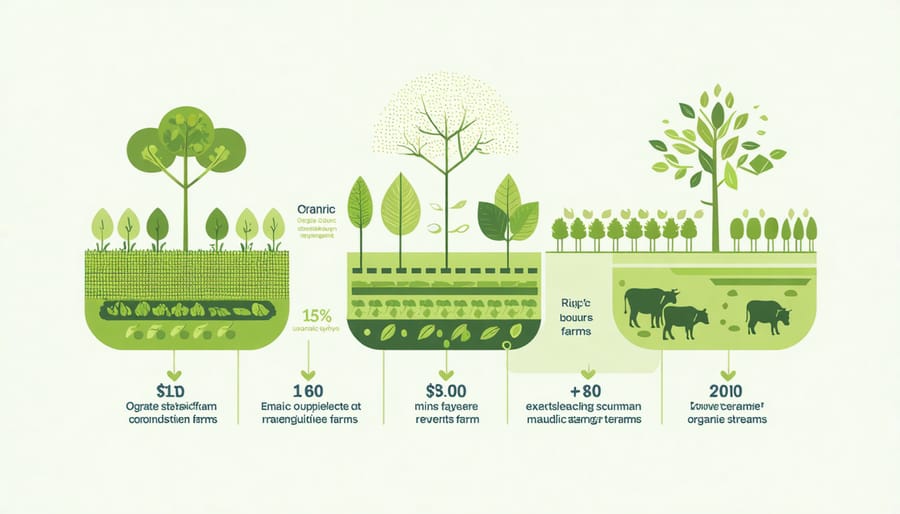
Transitioning to organic farming in Alberta presents a viable path to profitability, supported by growing market demand and established support systems. While the journey requires careful planning and initial investment, the potential for premium pricing and reduced input costs makes it financially attractive for many farmers. Success stories across the province demonstrate that with proper certification, marketing strategies, and resource management, organic operations can thrive in our climate.
For farmers considering the transition, start by connecting with local organic associations, attending workshops, and developing a detailed business plan. Take advantage of available government grants and mentorship programs. Remember that profitability often increases after the transition period as soil health improves and operational efficiencies develop. Whether you’re managing a small family farm or larger operation, organic farming offers a sustainable path forward that benefits both your bottom line and our agricultural community.

